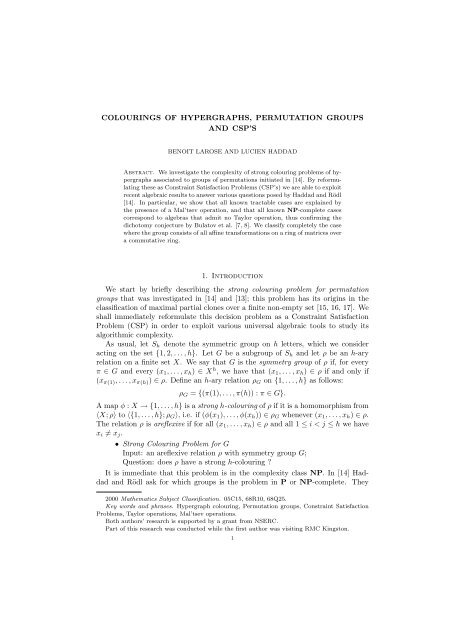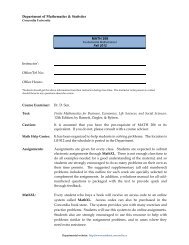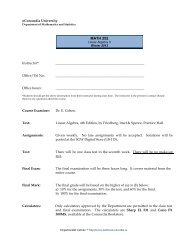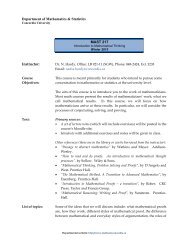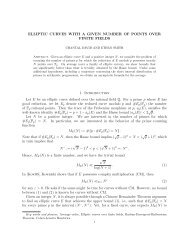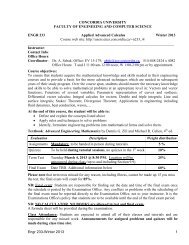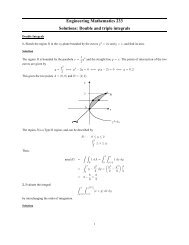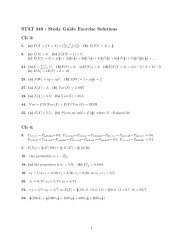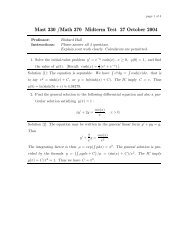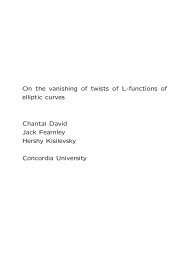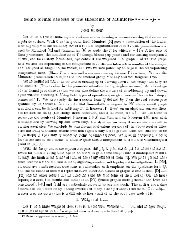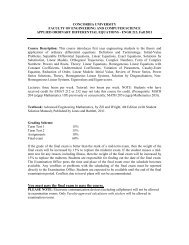COLOURINGS OF HYPERGRAPHS, PERMUTATION GROUPS ...
COLOURINGS OF HYPERGRAPHS, PERMUTATION GROUPS ...
COLOURINGS OF HYPERGRAPHS, PERMUTATION GROUPS ...
You also want an ePaper? Increase the reach of your titles
YUMPU automatically turns print PDFs into web optimized ePapers that Google loves.
<strong>COLOURINGS</strong> <strong>OF</strong> <strong>HYPERGRAPHS</strong>, <strong>PERMUTATION</strong> <strong>GROUPS</strong><br />
AND CSP’S<br />
BENOIT LAROSE AND LUCIEN HADDAD<br />
Abstract. We investigate the complexity of strong colouring problems of hypergraphs<br />
associated to groups of permutations initiated in [14]. By reformulating<br />
these as Constraint Satisfaction Problems (CSP’s) we are able to exploit<br />
recent algebraic results to answer various questions posed by Haddad and Rödl<br />
[14]. In particular, we show that all known tractable cases are explained by<br />
the presence of a Mal’tsev operation, and that all known NP-complete cases<br />
correspond to algebras that admit no Taylor operation, thus confirming the<br />
dichotomy conjecture by Bulatov et al. [7, 8]. We classify completely the case<br />
where the group consists of all affine transformations on a ring of matrices over<br />
a commutative ring.<br />
1. Introduction<br />
We start by briefly describing the strong colouring problem for permutation<br />
groups that was investigated in [14] and [13]; this problem has its origins in the<br />
classification of maximal partial clones over a finite non-empty set [15, 16, 17]. We<br />
shall immediately reformulate this decision problem as a Constraint Satisfaction<br />
Problem (CSP) in order to exploit various universal algebraic tools to study its<br />
algorithmic complexity.<br />
As usual, let S h denote the symmetric group on h letters, which we consider<br />
acting on the set {1, 2, . . . , h}. Let G be a subgroup of S h and let ρ be an h-ary<br />
relation on a finite set X. We say that G is the symmetry group of ρ if, for every<br />
π ∈ G and every (x 1 , . . . , x h ) ∈ X h , we have that (x 1 , . . . , x h ) ∈ ρ if and only if<br />
(x π(1) , . . . , x π(h) ) ∈ ρ. Define an h-ary relation ρ G on {1, . . . , h} as follows:<br />
ρ G = {(π(1), . . . , π(h)) : π ∈ G}.<br />
A map φ : X → {1, . . . , h} is a strong h-colouring of ρ if it is a homomorphism from<br />
〈X; ρ〉 to 〈{1, . . . , h}; ρ G 〉, i.e. if (φ(x 1 ), . . . , φ(x h )) ∈ ρ G whenever (x 1 , . . . , x h ) ∈ ρ.<br />
The relation ρ is areflexive if for all (x 1 , . . . , x h ) ∈ ρ and all 1 ≤ i < j ≤ h we have<br />
x i ≠ x j .<br />
• Strong Colouring Problem for G<br />
Input: an areflexive relation ρ with symmetry group G;<br />
Question: does ρ have a strong h-colouring <br />
It is immediate that this problem is in the complexity class NP. In [14] Haddad<br />
and Rödl ask for which groups is the problem in P or NP-complete. They<br />
2000 Mathematics Subject Classification. 05C15, 68R10, 68Q25.<br />
Key words and phrases. Hypergraph colouring, Permutation groups, Constraint Satisfaction<br />
Problems, Taylor operations, Mal’tsev operations.<br />
Both authors’ research is supported by a grant from NSERC.<br />
Part of this research was conducted while the first author was visiting RMC Kingston.<br />
1
2 B. LAROSE AND L. HADDAD<br />
give various examples of both types of behaviour, and in [13] Haddad, Hell and<br />
Mendelsohn investigate this problem further.<br />
We now reformulate this decision problem in a more convenient form. Let A =<br />
{1, . . . , h}.<br />
• CSP (ρ G )<br />
Input: a relational structure 〈X; µ〉 where µ is h-ary;<br />
Question: is there a homomorphism from 〈X; µ〉 to 〈A; ρ G 〉 <br />
It is easy to see that in fact these problems are equivalent. Indeed, it is clear<br />
that if the input structure for CSP (ρ G ) is not areflexive then there cannot be a<br />
homomorphism. Furthermore, it is easy to verify that if a homomorphism exists,<br />
and if both (x 1 , . . . , x h ) and (x π(1) , . . . , x π(h) ) are in µ then π ∈ G. Finally, we can<br />
always add to µ all permutation of its tuples by permutations in G without changing<br />
the set of solutions. Obviously all these steps can be done in time polynomial in<br />
the size of the structure 〈X; µ〉 and thus we may safely restrict the inputs to the<br />
problem CSP (ρ G ) (abbreviated from now as CSP (G)) to areflexive structures with<br />
symmetry group G.<br />
More generally, for any finite set of relations R = {ρ 1 , . . . , ρ k } on A where ρ i has<br />
arity d i , let CSP (R) denote the following decision problem:<br />
• CSP (R)<br />
Input: a relational structure 〈X; µ 1 , . . . , µ k 〉 where µ i is d i -ary;<br />
Question: is there a homomorphism from 〈X; µ 1 , . . . , µ k 〉 to 〈A; ρ 1 , . . . , ρ k 〉 <br />
In 1993, Feder and Vardi [11] conjectured that, depending on the constraint<br />
relations, the problem CSP (ρ 1 , . . . , ρ k ) should be either in P or NP-complete.<br />
This dichotomy conjecture has attracted a great deal of attention lately (see for<br />
example [3, 4, 5, 7, 9, 12, 22, 23, 24, 25, 31]), and the conjecture has been settled in<br />
various special cases. A deep connection with universal algebra was uncovered by<br />
P. Jeavons [22] and further refined in collaboration with Bulatov and Krokhin [7, 8].<br />
They have stated a precise conjecture predicting which sets of relations should give<br />
rise to tractable problems and which are NP-complete (a conjecture along the same<br />
lines is sketched in [12].) We now state the precise conjecture and briefly outline<br />
the necessary background (we refer the reader to [20], [32] and [34] for basic results<br />
in universal algebra.)<br />
Let f be an n-ary operation on a set A and let θ be a k-ary relation on A. We<br />
say that f preserves θ or that θ is invariant under f if the following holds: given<br />
any matrix M of size k × n whose columns are in θ, applying f to the rows of M<br />
will produce a k-tuple in θ. Given a set R of relations on A, we define P ol(R) to<br />
be the set of all operations on A that preserve all relations in R. Jeavons observed<br />
that the complexity of the problem CSP (R) is essentially determined by P ol(R).<br />
Bulatov, Jeavons and Krokhin prove that, to settle the dichotomy conjecture, it<br />
is sufficient to consider sets of relations R such that every member of P ol(R) is<br />
surjective [7]. When a set of relations has this property we say that it is a core. 1<br />
An operation f on A of arity at least 2 is idempotent if it satisfies the identity<br />
f(x, . . . , x) ≈ x (where ≈ indicates the equality holds with all variables universally<br />
quantified). Equivalently, an operation on A is idempotent if it preserves every<br />
1 More precisely, we should say that the relational structure 〈A; R〉 is a core, i.e. that all its<br />
endomorphisms are automorphisms, see for instance [12] or [19]. Every finite relational structure<br />
has, up to isomorphism, a unique core, and the CSP problems for the structure and its core are<br />
poly-time equivalent [7].
<strong>COLOURINGS</strong> <strong>OF</strong> <strong>HYPERGRAPHS</strong>, <strong>PERMUTATION</strong> <strong>GROUPS</strong> AND CSP’S 3<br />
unary relation of the form {a} for a ∈ A. An n-ary idempotent operation f is a<br />
Taylor operation if it satisfies, for every 1 ≤ i ≤ n an identity of the form<br />
f(x 1 , . . . , x i−1 , x, x i+1 , . . . , x n ) ≈ f(y 1 , . . . , y i−1 , y, y i+1 , . . . , y n )<br />
where x j , y j ∈ {x, y} for all 1 ≤ j ≤ n (see [35], [20]). For instance, a binary<br />
operation is a Taylor operation if and only if it is idempotent and commutative; in<br />
particular, semilattice operations are Taylor operations. Here are other common<br />
instances of Taylor operations:<br />
- a 3-ary operation M is a majority operation if it satisfies the identities<br />
M(x, x, y) ≈ M(x, y, x) ≈ M(y, x, x) ≈ x.<br />
- a 3-ary operation m is a Mal’tsev operation if it satisfies<br />
m(x, x, y) ≈ m(y, x, x) ≈ y.<br />
The following hardness criterion was first proved in [7] in a different formulation,<br />
but may be found in the present form in [31].<br />
Theorem 1.1. Let R be a core. If P ol(R) contains no Taylor operation then the<br />
problem CSP (R) is NP-complete.<br />
It is conjectured that, in essence, this is the only reason why a constraint satisfaction<br />
problem is hard:<br />
Dichotomy Conjecture ([7]). Let R be a core. If P ol(R) contains a Taylor<br />
operation then CSP (R) is in P; otherwise it is NP-complete.<br />
We view our investigation of the decision problems CSP (G) as an opportunity to<br />
pursue the study of this conjecture in a context with a rather different flavour from<br />
the cases that have been studied so far. Secondly, the algebra A G is of independent<br />
interest because its clone of term operations is the largest element of the so-called<br />
monoidal interval determined by the group G; these intervals have attracted some<br />
attention in the recent literature (see for example [26, 27, 28, 33]) and we shall feel<br />
free to analyse in more detail some of the idempotent terms of these algebras.<br />
We now briefly outline the contents of the paper. We shall prove that in all known<br />
cases where CSP (G) is in P, there is a Taylor operation that preserves the relation<br />
ρ G ; in fact, we shall exhibit a Mal’tsev operation in every case. This includes the<br />
cases of regular groups, primitive groups and wreath products of these (Proposition<br />
3.1, Corollary 3.4 and Theorem 3.2). Furthermore, we prove that in all known NPcomplete<br />
cases there is no Taylor operation, confirming the dichotomy conjecture,<br />
and further proving that the problem cannot be of so-called bounded width (see<br />
[30]). We shall also present some evidence that the classification of the tractable<br />
cases cannot avoid the intransitive groups, see subsection 3.3. In particular, we<br />
answer in section 4 the following question posed by Haddad and Rödl [14]: is there<br />
a group G for which CSP (G) is NP-complete but such that its actions on orbits<br />
are tractable We construct an infinite family of such examples. We shall also<br />
answer another question posed in the same paper, namely, we provide an infinite<br />
family of tractable CSP (G) such that G is transitive and has a (normal) transitive<br />
subgroup H such that CSP (H) is NP-complete. Finally, we shall completely<br />
classify the complexity of the problem when the permutation group G consists of<br />
all transformations of the form x ↦→ ax + b where a and b are n × n matrices over<br />
some commutative ring S and a in invertible (Theorem 4.5).
4 B. LAROSE AND L. HADDAD<br />
Acknowledgments.<br />
The authors wish to thank Ágnes Szendrei and Keith Kearnes for fruitful discussions.<br />
2. Preliminaries<br />
Unless otherwise specified, the groups we consider in the sequel are concrete<br />
groups of permutations. Recall that for G a group of permutations on A and x ∈ A,<br />
the set of all σ(x) with σ ∈ G is called the orbit of x under G. The group G is<br />
transitive if it has a single orbit, i.e. for every x, y ∈ A there exists σ ∈ G such that<br />
σ(x) = y. For x ∈ A the stabiliser of x is the subgroup G x = {σ ∈ G : σ(x) = x};<br />
for S ⊆ A the (set-wise) stabiliser of S is G S = {σ ∈ G : σ(S) ⊆ S}. A transitive<br />
group G is regular if for each x and y in A the permutation taking x into y is<br />
unique; equivalently, if every non-identity permutation in G is fixed-point free, i.e.<br />
|G x | = 1 for all x ∈ A. A group G is primitive if there is no non-trivial equivalence<br />
relation θ on the set A which is invariant under the permutations of G (viewed as<br />
unary operations on A).<br />
It will be convenient (and interesting) from time to time to consider our problem<br />
from an algebraic point of view. For any group of permutations G on a set A let<br />
A G denote the (non-indexed) algebra 〈A; P ol ρ G 〉. A set of operations on A which<br />
contains all projections and is closed under composition is called a clone. It is easy<br />
to verify that P ol ρ G is a clone; its members are called the terms of the algebra<br />
A G . The unary part of a clone C is the set of its unary operations. It is a simple<br />
exercise to verify the following fact: a clone C has unary part equal to G if and<br />
only if it is contained in the clone P ol ρ G . In particular, the only unary operations<br />
that preserve ρ G are the members of G, and hence the relational structure 〈A; ρ G 〉<br />
is a core. Thus Theorem 1.1 above can be invoked to prove NP-hardness.<br />
Since a Taylor operation preserving the relation ρ G is an idempotent term of the<br />
algebra A G , we may use the following technique to produce “obstructions” to the<br />
existence of such a term. A k-ary relation µ on A is an idempotent k-subalgebra of<br />
A G if it is preserved by every idempotent term of A G . (In other words, these are<br />
the subalgebras of the algebra B k where B is the idempotent reduct of A.) When<br />
the arity of the relation is clear we shall simply say idempotent subalgebra.<br />
Alternatively, these relations can be described as follows. A first-order formula<br />
φ in the language of ρ G (with equality and constants) is primitive positive if it is<br />
built up using only the existential quantifier and conjunction, i.e. of the form<br />
φ ≡ ∃x 1 · · · ∃x m ψ<br />
where ψ is a conjunction of atomic formulas involving ρ G , equality and the unary<br />
relations {a} for every a ∈ A.<br />
Lemma 2.1 ([1]). Let µ be a k-ary relation on A. Then µ is an idempotent<br />
k-subalgebra if and only if there exists a primitive positive first-order formula<br />
φ(x 1 , . . . , x k ) in the language of ρ G (with equality and constants) with free variables<br />
x 1 , . . . , x k such that<br />
µ = {(a 1 , . . . , a k ) : φ(a 1 , . . . , a k ) holds}.<br />
Here are examples of such constructions. Let θ be a k-ary relation on A. For<br />
each sequence of indices I = (i 1 , . . . , i j ) where 1 ≤ i s ≤ k for all s, we define the
<strong>COLOURINGS</strong> <strong>OF</strong> <strong>HYPERGRAPHS</strong>, <strong>PERMUTATION</strong> <strong>GROUPS</strong> AND CSP’S 5<br />
projection of θ onto I by<br />
θ I = {(x 1 , x 2 , . . . , x j ) : ∃(y 1 , . . . , y k ) ∈ θ such that y i1 = x 1 , . . . , y ij = x j }.<br />
If θ is an idempotent k-subalgebra of A G then θ I is an idempotent j-subalgebra.<br />
We are also allowed to use constants, since we are considering idempotent terms.<br />
For instance, if θ is a k-ary idempotent subalgebra and a j+1 , . . . , a k ∈ A we may<br />
build the idempotent j-subalgebra<br />
{(x 1 , x 2 , . . . , x j ) : ∃ y ∈ θ such that y 1 = x 1 , . . . , y j = x j , y j+1 = a j+1 , . . . , y k = a k }<br />
where y = (y 1 , . . . , y k ).<br />
The following simple application will illustrate the method. Suppose the group<br />
G is doubly transitive on A, i.e. for every pairs (a, b), (c, d) ∈ A 2 there exists a<br />
permutation σ ∈ G such that σ(a) = c and σ(b) = d. Consider the projection of<br />
ρ G onto I = (1, 2); it is obviously the inequality relation {(a, b) : a ≠ b}, in other<br />
words, the adjacency relation of the complete graph on A. For |A| > 2, this graph is<br />
invariant under no Taylor operation; in fact, this result holds for all non-bipartite,<br />
symmetric, areflexive graphs (see Lemma 4.2 below). It follows that the relation ρ G<br />
is invariant under no Taylor operation, and hence that CSP (G) is NP-complete,<br />
by Theorem 1.1.<br />
On the other hand, Conjecture 1 has been verified for various special cases of<br />
Taylor terms. We mention here the results we will require in the sequel. It is easy to<br />
verify that on any group 〈A; ·〉, the term operation m(x, y, z) = xy −1 z is a Mal’tsev<br />
operation; and a k-ary relation on A is invariant under m if and only if it is a coset<br />
of a subgroup of A k . The following result is due to Feder and Vardi:<br />
Theorem 2.2 ([12]). Let 〈A; ρ 1 , . . . , ρ k 〉 be a relational structure such that the<br />
relations ρ 1 , . . . , ρ k are invariant under the operation m(x, y, z) = xy −1 z for some<br />
group operation on A. Then the problem CSP (ρ 1 , . . . , ρ k ) is in P.<br />
More generally, we have the following result due to Bulatov (see also Dalmau’s<br />
recent [9] for a short proof):<br />
Theorem 2.3 ([6]). Let 〈A; ρ 1 , . . . , ρ k 〉 be a relational structure such that the relations<br />
ρ 1 , . . . , ρ k are invariant under some Mal’tsev operation on A. Then the<br />
problem CSP (ρ 1 , . . . , ρ k ) is in P.<br />
The discriminator on the set A is the 3-ary operation defined by<br />
{<br />
z, if x = y,<br />
t(x, y, z) =<br />
x, otherwise.<br />
It is easy to see that t is a Mal’tsev operation; it also satisfies the identity t(x, y, x) ≈<br />
x, and the composition t(x, t(x, y, z), z) is a majority operation. Thus if ρ G is<br />
invariant under t the problem CSP (G) is in P, and in fact is of bounded width, by<br />
a result of Jeavons, Cohen and Cooper [23].<br />
3. Regular groups, wreath products and simple algebras<br />
3.1. Regular groups. In [14] it is shown that if G is regular then CSP (G) is<br />
tractable. We generalise this slightly, with an altogether different proof.<br />
Proposition 3.1. If G is a group of permutations on A such that |G x | = 1 for all<br />
x ∈ A, then the discriminator t preserves ρ G , and hence CSP (G) is in P. If G is<br />
transitive, then the discriminator preserves ρ G if and only if G is regular.
6 B. LAROSE AND L. HADDAD<br />
Proof. Suppose that |G x | = 1 for all x ∈ A: if α, β, γ ∈ G are such that α(x) = β(x)<br />
for some x ∈ A, then α = β, and hence t(α(x), β(x), γ(x)) = γ(x) for all x ∈ A.<br />
Otherwise, t(α(x), β(x), γ(x)) = α(x) for all x ∈ A and so t preserves ρ G .<br />
Now suppose that G is transitive. If G is not regular, we can find α, β ∈ G and<br />
x, y ∈ A such that α(x) = β(x) and α(y) ≠ β(y). Let γ ∈ G such that γ(x) = α(y).<br />
Apply the discriminator t to the tuples of ρ G corresponding to α, β and γ: we get<br />
that t(α(x), β(x), γ(x)) = γ(x) and t(α(y), β(y), γ(y)) = α(y); since these values<br />
are equal t cannot preserve ρ G .<br />
□<br />
We note in passing that there is another Mal’tsev operation that preserves the<br />
relation ρ G in the case where |G x | = 1 for all x ∈ A. Indeed, suppose that G has k<br />
orbits. Consider the action of G on the set G×{1, . . . , k} defined by (g ′ , i) g = (gg ′ , i)<br />
(i.e. G acts by left translations on each separate fiber {(x, i) : x ∈ G}.) It is easy<br />
to see that this action is equivalent to the action of G on A, and that the operation<br />
m(x, y, z) = xy −1 z of the group G × Z/kZ preserves ρ G .<br />
3.2. Wreath products. We expand on a result of [13] concerning wreath products<br />
of transitive permutation groups. Let H be a group of permutations on A an K a<br />
group of permutations on B. The wreath product of H and K, denoted by H ≀ K, is<br />
the group of permutations on A × B that consists of all permutations of the form<br />
(a, b) ↦−→ (α b (a), β(b))<br />
where β ∈ K and α b ∈ H for each b ∈ B (see [18]).<br />
Without loss of generality let us assume that A = {1, . . . , h} and B = {1, . . . , k}<br />
for some integers h, k ≥ 2. Then the relation ρ H≀K is, up to permutations of indices,<br />
the hk-ary relation containing all tuples of the form<br />
((α 1 (1), β(1)), . . . , (α 1 (h), β(1)), (α 2 (1), β(2)), . . . , . . . , (α k (1), β(k)),<br />
. . . , (α k (h), β(k)))<br />
where the α i are elements of H and β is in K.<br />
Theorem 3.2. Let h, k ≥ 2, let A = {1, . . . , h} and B = {1, . . . , k}, and let H and<br />
K be transitive groups of permutations on A and B respectively.<br />
(1) the relation ρ H≀K is invariant under a Taylor operation if and only if the<br />
same holds for ρ H and ρ K ;<br />
(2) each of the problems CSP (ρ H ) and CSP (ρ K ) reduces to CSP (ρ H≀K ) in<br />
polynomial time;<br />
(3) if both the problems CSP (ρ H ) and CSP (ρ K ) are in P then so is CSP (ρ H≀K ).<br />
Proof. Part (3) was proved in [13].<br />
It is easy to verify the following: (∗) if f and g are n-ary operations preserving<br />
ρ H and ρ K respectively then the operation<br />
(f, g)((x 1 , y 1 ), . . . , (x n , y n )) = (f(x 1 , . . . , x n ), g(y 1 , . . . , y n ))<br />
preserves ρ H≀K .<br />
Now we prove a claim which we’ll use to prove both (1) and (2): consider the<br />
binary relation θ on A×B defined as follows: θ consists of all pairs ((x 1 , y 1 ), (x ′ 1, y 1))<br />
′<br />
such that there exist (x i , y i ), (x ′ i , y′ i ), i = 1, . . . , hk, such that ((x 1, y 1 ), (x 2 , y 2 ), . . . )<br />
and ((x ′ 1, y 1), ′ (x ′ 2, y 2), ′ . . . ) are in ρ H≀K and (x i , y i ) = (x ′ i , y′ i ) for all i ≥ h + 1. It<br />
is not difficult to see that ((x 1 , y 1 ), (x ′ 1, y 1)) ′ ∈ θ if and only if y 1 = y 1. ′ Thus θ is
<strong>COLOURINGS</strong> <strong>OF</strong> <strong>HYPERGRAPHS</strong>, <strong>PERMUTATION</strong> <strong>GROUPS</strong> AND CSP’S 7<br />
a congruence of the algebra A H≀K , and we may safely identify the blocks of θ with<br />
the elements of B. In particular, every term of A H≀K has the form<br />
Φ((x 1 , y 1 ), . . . , (x n , y n )) = (. . . , g(y 1 , . . . , y n ))<br />
for some operation g on K. In fact, the quotient algebra is term-equivalent to A K .<br />
Indeed, every term operation of A K is obtained as the “action” of a term of A H≀K<br />
on the blocks of θ: if g is the term of A K take (π 1 , g) as the term of A H≀K . On<br />
the other hand, the unary part of the clone of the quotient algebra is the action<br />
of H ≀ K on the blocks of θ, which is easily seen to be that of K. Since A K is the<br />
algebra whose clone is the largest with this property, we get the result.<br />
Now we prove that the subset A ′ = {(a, 1) : a ∈ A} is an idempotent subalgebra<br />
of A H≀K ; we may identify it in the obvious way to A. If Φ is an idempotent term<br />
of A H≀K then the associated term g (see above) of A K is clearly idempotent, and<br />
the result follows immediately.<br />
If Φ is an idempotent term of A H≀K then it must preserve the following relation:<br />
{((x 1 , y 1 ), . . . , (x h , y h )) : ((x 1 , y 1 ), . . . , (x h , y h ), (1, 2), . . . , (h, 2), . . . , (1, k),<br />
. . . , (h, k)) ∈ ρ H≀K }<br />
which is easily seen to be equal to<br />
{(α(1), 1), . . . , (α(h), 1) : α ∈ H}.<br />
This shows that the idempotent subalgebra of A H≀K with universe A ′ is a reduct of<br />
the algebra A H . Now if f is an idempotent term of A H then the operation (f, π 1 )<br />
is a term of A H≀K so the idempotent subalgebra is actually term-equivalent to the<br />
idempotent reduct of the algebra A H .<br />
This shows that if A H≀K has a Taylor operation then so do A H and A K , and by<br />
Theorem 7 of [31] that (2) holds.<br />
Conversely, suppose that f is an n-ary term of A H and g is a m-ary term of A K .<br />
Define an (n + m)-ary term of A H≀K by<br />
Φ((x 1 , y 1 ), . . . , (x n+m , y n+m )) = (f(x 1 , . . . , x n ), g(y n+1 , . . . , y n+m ));<br />
notice that it is a term of A H≀K by (∗) because it is of the form (f ′ , g ′ ) where f ′<br />
and g ′ are obtained from f and g respectively by adding fictitious variables.<br />
It is easy to verify the following: if f satisfies the identity<br />
then Φ satisfies the identity<br />
f(u 1 , . . . , u n ) ≈ f(v 1 , . . . , v n )<br />
Φ(u 1 , . . . , u n , x, x, . . . , x) ≈ φ(v 1 , . . . , v n , x, x, . . . , x)<br />
and similarly for g; in particular, Φ is a Taylor operation if both f and g are Taylor,<br />
which proves (1).<br />
□<br />
Remark. If A H and A K each have Taylor terms f and g of the same arity that obey<br />
the same linear identities, then A H≀K will have a term obeying those identities.<br />
Indeed, it suffices to identify variables in the term defined in the last proof, as<br />
follows:<br />
Ψ((x 1 , y 1 ), . . . , (x n , y n )) = Φ((x 1 , y 1 ), . . . , (x n , y n ), (x 1 , y 1 ), . . . , (x n , y n )).<br />
In particular, A H≀K admits a Mal’tsev term or majority term if and only if both<br />
A H and A K do.
8 B. LAROSE AND L. HADDAD<br />
3.3. Simple algebras. If we wish to determine whether there exists a Taylor term<br />
that preserves the relation ρ G , it seems natural to try to break down the problem<br />
into smaller parts, as for instance, if G can be decomposed as a wreath product of<br />
smaller groups. In another vein, if G is not transitive on A, then we may consider<br />
its actions on orbits: for each orbit A ′ ⊆ A, we have a group of permutations G ′<br />
on A ′ consisting of the restrictions of the members of G to A ′ . In [14], Haddad<br />
and Rödl ask whether there exists a group G such that for every group G ′ obtained<br />
this way, the problem CSP (G ′ ) is in P, but CSP (G) is NP-complete; we shall<br />
provide examples in the next section. Unfortunately, it seems unlikely that a characterisation<br />
of the tractable cases can be obtained in the transitive case only, as<br />
the following discussion will show.<br />
Another approach to break down our problem is to use congruences of the algebra<br />
A G , and analyse the quotients. We require the following result from [33] (see also<br />
Lemma 3.5 of [26]):<br />
Lemma 3.3. Let G be a transitive group of permutations on A and let A be a<br />
simple algebra whose clone of term operations has unary part equal to G. Then<br />
either G is regular or A is essentially unary.<br />
Corollary 3.4. Let G be a transitive group of permutations on A. If the algebra<br />
A G is simple, in particular if the group G is primitive, then A G has a Taylor term<br />
if and only if the discriminator is a term of A G . If this holds CSP (G) is in P,<br />
otherwise it is NP-complete.<br />
Proof. If the algebra A G has a Taylor term then it is not essentially unary; the<br />
result then follows immediately from Lemma 3.3 and Proposition 3.1. □<br />
Suppose that G is transitive and that A G is not simple. If α is a maximal<br />
congruence of A G then the quotient algebra A G /α is simple; furthermore the unary<br />
part of its clone of term operations consists of the permutations of the blocks of α<br />
induced by the elements of G; this is a transitive group, and thus by Lemma 3.3<br />
either the quotient algebra is essentially unary, and hence A G has no Taylor term,<br />
or else the action of G on the blocks of α is regular. Then the following is a term<br />
operation of A G :<br />
{<br />
z, if (x, y) ∈ α,<br />
T (x, y, z) =<br />
x, otherwise.<br />
Indeed, if σ, τ, µ ∈ G are such that (σ(x), τ(x)) ∈ α for some x ∈ A, then the same<br />
holds for every x ∈ A by regularity on the blocks. Thus T (σ(x), τ(x), µ(x)) = µ(x)<br />
for all x ∈ A. Otherwise we get T (σ(x), τ(x), µ(x)) = σ(x) for all x ∈ A and so T<br />
preserves ρ G .<br />
Hence we obtain the following:<br />
Proposition 3.5. Let G be a transitive group of permutations on A. If A G has a<br />
Taylor term then it has a quotient with a discriminator term.<br />
Lemma 3.6. Let G be a transitive group of permutations on A, let α be a congruence<br />
of A G such that G acts regularly on the blocks of α; let B be a block of α and<br />
let H = G B . If the relation ρ G is invariant under a Taylor operation then so is<br />
ρ H . If the relation ρ H is invariant under a Mal’tsev operation then so is ρ G .<br />
Proof. As we remarked earlier, the fact that G acts regularly on the blocks of α<br />
translates as follows: for any σ, τ ∈ G, if there exists some x ∈ A such that σ(x) and
<strong>COLOURINGS</strong> <strong>OF</strong> <strong>HYPERGRAPHS</strong>, <strong>PERMUTATION</strong> <strong>GROUPS</strong> AND CSP’S 9<br />
τ(x) are in the same block of α then the same holds for every x ∈ A. In particular,<br />
the relation ρ H is an idempotent k-subalgebra since it is equal to<br />
ρ H = {(x 1 , . . . , x k ) ∈ ρ G : (x 1 , 1) ∈ α}<br />
(and α, being a congruence, is itself an idempotent subalgebra.) It follows that if<br />
f is a Taylor operation preserving ρ G , it also preserves ρ H .<br />
Now suppose that ρ H is invariant under a Mal’tsev operation f. We define an<br />
operation on A as follows: let φ(x, y, z) = f(x, y, z) whenever x, y, z lie in the same<br />
block of α. If x, y, z are not in the same block, let φ(x, y, z) = z if (x, y) ∈ α and<br />
φ(x, y, z) = x otherwise.<br />
It is easy to verify that φ is a Mal’tsev operation; we must now show that it<br />
preserves ρ G . Let σ, τ, µ ∈ G. First suppose that σ(x), τ(x), µ(x) are all in the<br />
same block of α for some x: this will then hold for all x ∈ A. In particular, we get<br />
that the tuples corresponding to the identity permutation, τ ◦ σ −1 and µ ◦ σ −1 are<br />
all in ρ H .<br />
Notice that if (x 1 , . . . , x k ) ∈ ρ G , then (x ν(1) , . . . , x ν(k) ) ∈ ρ G if and only if ν ∈ G.<br />
Indeed, if (x 1 , . . . , x k ) corresponds to π ∈ G and (x ν(1) , . . . , x ν(k) ) corresponds to<br />
ξ ∈ G then we have that π ◦ ν = ξ. Thus we proceed as follows: if M is the<br />
|G| × 3 matrix whose rows are the tuples corresponding to σ, τ, µ, permute the rows<br />
using σ −1 to obtain columns that are members of ρ H . Apply φ, which in this case<br />
amounts to applying f, and hence the resulting column is in ρ H . Now reorder the<br />
rows using σ to obtain φ(σ, τ, µ) which is in ρ G .<br />
Now suppose that σ(x), τ(x), µ(x) do not lie all in the same block of α but the<br />
first two do; then this holds for all x ∈ A. Hence φ(σ(x), τ(x), µ(x)) = µ(x) for all<br />
x. The remaining case is similar.<br />
□<br />
The second statement of the last lemma can be extended (for instance to majority<br />
operations). But is it true in general that if ρ H admits a Taylor operation then so<br />
does ρ G <br />
4. Dihedral groups and Affine transformations<br />
In this section we consider various examples of permutation groups and analyse<br />
which admit Taylor terms or not.<br />
4.1. Dihedral groups. In the following, we let D n (n ≥ 3) denote the 2n-element<br />
permutation group on {0, 1, . . . , n − 1} which is the automorphism group of the<br />
n-cycle, i.e. which is generated by the permutations (0 1 . . . n − 1) and (0 n −<br />
1)(1 n−2) · · · . The complexity of CSP (D n ) was first determined in [13] by different<br />
methods.<br />
Lemma 4.1. The relation ρ D4 is invariant under a Mal’tsev operation. In particular,<br />
the problem CSP (ρ D4 ) is in P.<br />
Proof. There are in fact many different Mal’tsev operations preserving this relation.<br />
Notice first that D 4 is the wreath product of two copies of the 2-element group,<br />
and hence admits the Mal’tsev operation<br />
((x, x ′ ), (y, y ′ ), (z, z ′ )) ↦→ (x + y + z, x ′ + y ′ + z ′ )<br />
where the sum is that of the group Z/2Z (see the comment following Theorem 3.2).<br />
Alternatively, one may invoke the results on affine transformations (see below), by
10 B. LAROSE AND L. HADDAD<br />
noticing that D 4 consists of all affine transformations x ↦→ ax + b with a, b ∈ Z/4Z<br />
and a invertible. It follows that the operation M(x, y, z) = x − y + z preserves ρ D4<br />
(where the sum is in Z/4Z.)<br />
□<br />
We shall now prove that no Taylor operation preserves the relation ρ Dn for n ≠ 4.<br />
For this we require the following results on graphs, one of which was mentioned<br />
earlier in section 2.<br />
Lemma 4.2 ([2], [30]). Let θ be a binary, areflexive, symmetric relation on a set<br />
A and let Γ be the associated simple graph. If Γ is not bipartite then θ is invariant<br />
under no Taylor operation.<br />
Let θ be a binary, reflexive relation. We’ll say that θ is intransitive if whenever<br />
(a, b), (b, c), (a, c) ∈ θ then |{a, b, c}| ≤ 2. We’ll say that θ is not acyclic if its<br />
symmetric closure (with all loops removed) is not a tree.<br />
Lemma 4.3 ([29]). Let θ be a binary, reflexive relation on A which is intransitive.<br />
If θ is not acyclic then it is invariant under no Taylor operation.<br />
Theorem 4.4. If n ≠ 4 then no Taylor operation preserves the relation ρ Dn ; in<br />
particular the problem CSP (D n ) is NP-complete.<br />
Proof. We divide the proof in 3 cases. Suppose first that n is odd: consider the<br />
projection θ of ρ Dn onto the coordinates 0 and 1 (an edge of the n-gon). It is easy<br />
to see that θ is symmetric, areflexive, and is in fact the n-cycle; by Lemma 4.2 we<br />
are done.<br />
Now suppose that n is even. Consider the relation α that consists of all pairs<br />
(x 0 , y 0 ) such that there exist (x 0 , . . . , x n−1 ), (y 0 , . . . , y n−1 ) ∈ ρ Dn with x 1 = y 1 . It<br />
is easy to see that<br />
α = {(x, y) : x − y = ±2}<br />
where the sum is taken modulo n. Thus α is a reflexive, symmetric relation. If n ≥ 8<br />
then this is an intransitive cycle so we apply Lemma 4.3; if n = 6, then α is a congruence<br />
of A D6 (on whose blocks D 6 acts regularly), and we define the idempotent<br />
subalgebra γ as the set of all pairs (x 0 , x 2 ) such that there exists (x 0 , . . . , x 5 ) ∈ ρ D6<br />
such that (x 0 , 0) ∈ θ. It is easy to see that γ is an areflexive, symmetric cycle of<br />
length 3, and hence Lemma 4.2 applies.<br />
□<br />
4.2. Affine transformations. In this section we completely determine the complexity<br />
of CSP (G) in the case where G is the group of all (bijective) affine transformations<br />
on a matrix ring. 2 (See [27] for a study of monoidal intervals related to<br />
affine transformations.) More precisely, let S be a (finite) commutative ring with<br />
1, let n be a positive integer and let R = M n (S) the ring of n × n matrices over<br />
S. Let U = GL n (S) denote the group of invertible matrices in M n (S). The group<br />
G = G n,R will consist of all transformations on R of the form x ↦→ ax + b where<br />
a ∈ U and b ∈ R. It is clear that G acts transitively on R.<br />
Theorem 4.5. Let G = G n,R . Then the following conditions are equivalent:<br />
(1) A G admits a Taylor term;<br />
(2) n = 1 and the operation m(x, y, z) = x − y + z is a term of A G .<br />
If one of these conditions holds then CSP (G) is in P; otherwise it is NP-complete.<br />
2 For basic results on rings we refer the reader to [10] and [21].
<strong>COLOURINGS</strong> <strong>OF</strong> <strong>HYPERGRAPHS</strong>, <strong>PERMUTATION</strong> <strong>GROUPS</strong> AND CSP’S 11<br />
Proof. It will suffice to prove that (1) implies (2). We start by showing that if A G<br />
has a Taylor term then n = 1. For any non-zero c ∈ R, the orbit of (0, c) under G is<br />
invariant under the Taylor term (since it is a projection of ρ G on two indices), and<br />
it is the edge relation of a simple graph. Indeed, it is easy to see that it consists of<br />
all pairs (x, y) in R 2 such that x − y ∈ Uc; since −U = U and 0 ∉ U it follows that<br />
the binary relation is symmetric and areflexive. It follows from Lemma 4.2 that the<br />
graph in question must be bipartite.<br />
Consider the special case where c = 1. The neighbourhood of 0 in this graph<br />
is the set U; since the graph contains no 3-cycle, there cannot be an edge between<br />
two elements of U. However, in the case n ≥ 2 consider the matrix<br />
⎡<br />
⎤<br />
0 · · · 0 1<br />
· · · · · · · · · 0<br />
B =<br />
.<br />
⎢· · · I n−1 · · · .<br />
⎥<br />
⎣· · · · · · · · · 0⎦<br />
· · · · · · · · · 1<br />
where as usual I n denotes the identity matrix of order n; in the matrix B the lower<br />
left hand corner consists of the identity matrix of order n − 1. The matrix B has<br />
determinant (−1) n and hence is in U. Furthermore, if we expand the determinant<br />
of the matrix<br />
⎡<br />
⎤<br />
−1 0 · · · · · · · · · 0 1<br />
1 −1 · · · · · · · · · 0 0<br />
0 1 −1 0 · · · 0 0<br />
B − I n =<br />
.<br />
.<br />
⎢ . .. . ..<br />
. .<br />
· · · · · · . .<br />
⎥<br />
⎢ .<br />
⎣<br />
. · · · · · · · · · 1 −1 0<br />
0 · · · · · · · · · 0 1 0<br />
following the first row we see that it is equal to (−1) n and hence is in U. Thus<br />
B and I n are adjacent elements of U, proving that if A G has a Taylor term then<br />
n = 1.<br />
So we may now assume that R (= S) is a commutative ring. Since it is finite, R is<br />
a product of local rings, i.e. R = R 1 ×· · ·×R v where each R i has a unique maximal<br />
ideal M i ; in particular, the group of units U i of R i consists of those elements not<br />
in M i . Also, note that U = U 1 × · · · × U v .<br />
Suppose that for some i there exist u, v ∈ U i such that u − v ∈ U i : we<br />
shall deduce a contradiction along the lines of the previous arguments. Let c =<br />
(0, . . . , 0, 1, 0, . . . , 0) where 1 appears in the i-th position, and consider the graph<br />
with set of edges equal to the orbit of (0, c). It is easy to see that (x, y) is an edge<br />
if and only if x − y = (0, . . . , 0, u i , 0, . . . , 0) for some u i ∈ U i . But then we have a<br />
3-cycle formed of the elements {0, (0, . . . , 0, u, 0, . . . , 0), (0, . . . , 0, v, 0, . . . , 0)}.<br />
Fix 1 ≤ i ≤ v. By the last paragraph, we have that u − v ∈ M i for all u, v ∈ U i .<br />
In particular, the (additive) factor group R i /M i has 2 elements. It follows that for<br />
each i, U i is a coset of M i and thus the set of units U is a coset of a subgroup<br />
of R. In particular U is closed under the operation m(x, y, z) = x − y + z. It<br />
follows that the relation ρ G is invariant under this operation: indeed, if α i ∈ G<br />
with α i (x) = a i x + b i for i = 1, . . . , 3 then we have that m(α 1 , α 2 , α 3 ) = γ where<br />
γ(x) = (a 1 − a 2 + a 3 )x + (b 1 − b 2 + b 3 ) for all x ∈ R.<br />
□<br />
⎥<br />
⎦
12 B. LAROSE AND L. HADDAD<br />
Observe that in the above proof we have a Taylor term if and only if R is a<br />
product of local rings R 1 ,. . . , R s with maximal ideal of size |R i |/2. For instance<br />
one may take products of the rings Z/kZ where k = 2 n . We use these groups to<br />
answer two questions posed in [14].<br />
Example 1. A transitive group G with a normal, transitive subgroup H such that<br />
CSP (G) is in P but CSP (H) is NP-complete.<br />
The example is G 1,R where R = Z/kZ where k = 2 m with m ≥ 3. We know<br />
that it admits a Mal’tsev operation. Consider the subgroup H defined by<br />
H = {σ : σ(x) = ax + b where a ∈ {−1, 1}}.<br />
Notice that H is the dihedral group D 2 m and we’ve seen above that the associated<br />
problem is NP-complete if m ≥ 3. It is a simple exercise to verify that H is normal<br />
in G.<br />
Example 2. A group G such that CSP (G) is NP-complete, but CSP (G ′ ) is in P<br />
for every G ′ which is the action of G on an orbit.<br />
For simplicity we consider the case of two orbits only. Let m ≥ 3 and let k = 2 m .<br />
For i = 1, 2 let<br />
A i = {(x, i) : x ∈ Z/kZ}.<br />
The group G consists of all permutations of A 1 ∪A 2 of the following form: for every<br />
elements a, b, c, d in Z/kZ with a and c odd and a = ±c, define<br />
{<br />
(ax + b, 1), if i = 1,<br />
σ (a,b,c,d) (x, i) =<br />
(cx + d, 2), if i = 2.<br />
One verifies easily that G is closed under composition, and it is clear that A 1 and<br />
A 2 are the orbits of G. It is also immediate to verify that the restriction G i of G to<br />
the orbit A i is equivalent to the group G 1,R with R = Z/kZ; thus CSP (G i ) is in<br />
P for i = 1, 2. However, we prove that ρ G is invariant under no Taylor operation.<br />
Assume that the indexing is chosen as follows:<br />
ρ G = {(σ(0, 1), . . . , σ(k − 1, 1), σ(0, 2), . . . , σ(k − 1, 2)}.<br />
Consider the following idempotent subalgebra:<br />
θ = {(x 0 , . . . , x k−1 ) : (x 0 , . . . , x k−1 , (0, 2), . . . , (k − 1, 2)) ∈ ρ G }.<br />
Since cx + d = x for all x implies that c = 1 and d = 0, it follows that we have<br />
θ = {((a0 + b, 1), . . . , (a(k − 1) + b, 1)) : a = ±1}<br />
which we recognise to be ρ Dk , which admits no Taylor operation.<br />
5. Conclusion<br />
We have shown that all known NP-complete cases of CSP (G) are explained by<br />
the absence of a Taylor operation. On the other hand, we have verified that all<br />
known tractable cases of CSP (G) admit a Taylor operation, and in fact, a Mal’tsev<br />
operation. This prompts the following question:<br />
Problem. Is there a (transitive) group G such that CSP (G) admits a Taylor<br />
operation but no Mal’tsev operation <br />
In view of Example 2 above and Proposition 3.6, it seems likely that an eventual<br />
classification of the tractable cases of CSP (G) will involve a somewhat detailed<br />
inspection of how subgroups of wreath products of tractable groups behave.
<strong>COLOURINGS</strong> <strong>OF</strong> <strong>HYPERGRAPHS</strong>, <strong>PERMUTATION</strong> <strong>GROUPS</strong> AND CSP’S 13<br />
References<br />
[1] V.G. Bodnar˘chuk, L.A. Kaluzhnin, V.N. Kotov, B.A. Romov, Galois theory for Post algebras<br />
I-II (russian), Kibernetica, 3 (1969), 1-10 and 5 (1969), 1-9. English version: Cybernetics,<br />
(1969), 243-252 and 531-539.<br />
[2] A. Bulatov, H-coloring dichotomy revisited, preprint, 2004, 16 pages.<br />
[3] A. Bulatov, A graph of a relational structure and Constraint Satisfaction Problems, preprint,<br />
2004, 10 pages.<br />
[4] A. Bulatov, Tractable conservative constraint satisfaction problems Technical report, Oxford<br />
University Computing Laboratory, submitted for publication 2003.<br />
[5] A. Bulatov, A dichotomy theorem for constraints on a three-element set, in Proceedings<br />
of 43rd IEEE Symposium on Foundations of Computer Science (FOCS’02), Vancouver,<br />
Canada, 649-658, 2002.<br />
[6] A. Bulatov, Malt’sev constraints are tractable, Research Report RR-02-05, Oxford University<br />
Computing Laboratory, April 2002, 36 pages.<br />
[7] A. Bulatov, P. Jeavons, A. Krokhin, Constraint satisfaction problems and finite algebras,<br />
in Proceedings of 27th International Colloquim on Automata, Languages and Programming<br />
(ICALP’00), Geneva, Switzerland, Lecture Notes in Computer Science 1853, (2000), 272–<br />
282.<br />
[8] A. Bulatov, P. Jeavons, A. Krokhin, Classifying the complexity of constraints using finite<br />
algebras, submitted, 2003, 30pp.<br />
[9] V. Dalmau, Mal’tsev contraints made simple, preprint, 2004, (9 pages).<br />
[10] D. S. Dummit, R. M. Foote, Abstract Algebra, 3rd Edition, 2004, Wiley.<br />
[11] T. Feder, M. Vardi, The computational structure of monotone monadic SNP and constraint<br />
satisfaction: a study through Datalog and group theory. Proc. 25th Ann. ACM Symp. on<br />
Theory of Computing (1993), 612–622.<br />
[12] T. Feder, M. Y. Vardi, The Computational Structure of Monotone Monadic SNP and Constraint<br />
Satisfaction: A Study through Datalog and Group Theory, SIAM Journal of Computing<br />
28 (1998), 57-104.<br />
[13] L. Haddad, P. Hell, E. Mendelsohn, On the complexity of coloring areflexive h-ary relations<br />
with given permutation group, Ars Combin. 48, (1998), 111–128.<br />
[14] L. Haddad, V. Rödl, On the complexity of coloring areflexive relations, Ars Combin. 33,<br />
(1992), 217-225.<br />
[15] L. Haddad and I.G. Rosenberg, Completness theory for finite partial algebras Algebra Universalis<br />
29 (1992) 378-401.<br />
[16] L. Haddad and I.G. Rosenberg, Maximal, partial clones determined by areflexive relations.<br />
Discrete Appl. Math. 24, (1989) 133–143.<br />
[17] L. Haddad and I. G. Rosenberg, Critère général de complétude pour les algèbres partielles<br />
finies, C.R. Acad. Sci. 304, Ser 1, No. 17 (1987) 507-509.<br />
[18] M. Hall, The Theory of Groups, 2nd edition, 1976, Chealsea, New York.<br />
[19] P. Hell, J. Nešetřil, Graphs and Homomorphisms, Oxford University Press, 2004.<br />
[20] D. Hobby, R. McKenzie, The structure of finite algebras, Contemporary Mathematics 76,<br />
American Mathematical Society, Providence, RI, 1988.<br />
[21] N. Jacobson, Basic Algebra II, 2nd edition, 1989, Freeman, New York.<br />
[22] P.G. Jeavons, On the Algebraic Structure of Combinatorial Problems, Theoret. Comput. Sci.<br />
200 (1998), 185-204.<br />
[23] P.G. Jeavons, D.A. Cohen, and M. Cooper, Constraints consistency and closure, Artificial<br />
Intelligence, 101 (1-2) (1998), 251–265.<br />
[24] P. G. Jeavons, D. A. Cohen, and M. Gyssens, Closure properties of constraints, Journal of<br />
the ACM. 44 no. 4, 527–548, 1997.<br />
[25] P. G. Kolaitis, M. Y. Vardi, Conjunctive-query containment and constraint satisfaction, in<br />
Proceedings of the seventeenth ACM SIGACT-SIGMOD-SIGART symposium on Principles<br />
of database systems, Seattle, Washington, 205–213, 1998.<br />
[26] K. Kearnes, Á. Szendrei, Collapsing permutation groups, Algebra Universalis 45 (2001),<br />
35-51.<br />
[27] A. A. Krokhin, On clones, transformation monoids, and associative rings, Algebra Universalis<br />
37 no. 4, (1997), 527 – 540.
14 B. LAROSE AND L. HADDAD<br />
[28] A. Krokhin, B. Larose, A finite monoïdal interval of isotone functions, Acta Sci. Math.<br />
(Szeged), 68, 2002, 37-62.<br />
[29] B. Larose, Taylor operations on finite reflexive structures, in preparation.<br />
[30] B. Larose, L. Zádori, Bounded width problems and algebras, (25 pages), submitted, 2004.<br />
[31] B. Larose, L. Zádori, The complexity of the extendibility problem for finite posets, SIAM J.<br />
Discrete Math., 17 (1) (2003), 114–121.<br />
[32] R.N. McKenzie, G.F. McNulty, W.F. Taylor, Algebras, Lattices and Varieties, Wadsworth<br />
and Brooks/Cole, Monterey California, 1987.<br />
[33] P. P. Pálfy, Á. Szendrei, Unary polynomials in algebras. II, in: Contributions to General<br />
Algebra 2 (Proc. Klagenfurt Conf., 1982), Verlag Hölder–Pichler–Tempsky, Wien and Verlag<br />
Teubner, Stuttgart, 1983; pp. 273–290.<br />
[34] Á. Szendrei, Clones in universal algebra, Sém. de Mathématiques Supérieures, 99, Séminaire<br />
Scientifique OTAN, les presses de l’Université de Montréal,1986.<br />
[35] W. Taylor, Varieties obeying homotopy laws, Canadian J. Math. 29 (1977), 498–527.<br />
Department of Mathematics and Statistics, Concordia University, 1455 de Maisonneuve<br />
West, Montréal, Qc, Canada, H3G 1M8<br />
E-mail address: larose@mathstat.concordia.ca<br />
URL: http://cicma.mathstat.concordia.ca/faculty/larose/<br />
Département de mathématiques et d’informatique, Collège militaire royal du Canada,<br />
Boîte Postale 17000, Station “Forces”, Kingston, Ontario, K7K 7B4 Canada<br />
E-mail address: haddad-l@rmc.ca<br />
URL: http://www.rmc.ca/academic/math-cs/haddad/index-e.html


